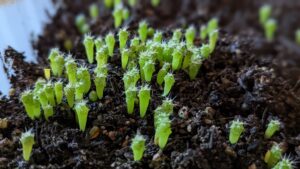When one thinks of Texas, images of cowboys, wide open spaces, and perhaps some of the most iconic landscapes in America come to mind. Yet, intertwined with these rugged terrains are the resilient forms of cacti – the botanical icons that thrive amidst the arid backdrop of the Lone Star State. But here’s a playful question: If you were to embark on a quest to find the most peculiar and stunning cacti of Texas, would you know where to begin? This challenge not only promises surreal discoveries but also highlights the unique ecological tapestry of this vast state.
The diversity of cacti in Texas is truly remarkable, with a plethora of species that adapt to the various climatic zones ranging from deserts to woodlands. This article delves into the iconic cacti found in Texas, examining their distinct characteristics, habitats, and the ecological significance they represent.
Cacti, characterized by their succulent stems and spines, serve as an exquisite testament to nature’s ability to thrive in harsh conditions. Particularly in Texas, where the extremes of heat and minimal rainfall have sculpted an environment that is as beautiful as it is challenging, cacti illustrate evolution at its finest.
As you traverse the sandy soils and rocky outcrops of Texas, several species of cacti are guaranteed to catch your eye, each contributing to the state’s rich biodiversity.
Now, let’s explore the cacti that have carved a niche in the Texan landscape.
The Prickly Pear – The Quintessential Texan Cactus
Among the most emblematic of Texas cacti is the Prickly Pear (Opuntia spp.). With its broad, flat pads adorned with glochid spines, this cactus is an unmistakable feature of the Texas flora. Ranging in color from vivid greens to shades of bluish-gray, these plants not only provide awe-inspiring aesthetics but also exhibit an extraordinary resilience to drought.
But what makes the Prickly Pear stand out? Its edible fruit, known as “tuna,” has been a vital resource for indigenous populations and modern-day foragers alike. Rich in vitamins and minerals, the paddle and fruit are celebrated for their culinary versatility.
The flowering period of the Prickly Pear is particularly striking. Bright yellow, red, or purple blooms burst forth during the spring and summer months, attracting a variety of pollinators, including bees and butterflies, thereby playing a crucial role in the local ecosystem.
The Saguaro – A Towering Sentinel
While not indigenous to Texas, the Saguaro (Carnegiea gigantea) is oftentimes associated with the southwestern United States. However, it can be found in the westernmost regions of Texas, particularly near Big Bend National Park. Reaching heights of up to 40 feet, these majestic cacti are truly a sight to behold.
The Saguaro is characterized by its iconic arms that extend skyward, giving it a silhouette that is instantly recognizable. Each arm can take decades to develop, embodying the slow yet steady growth that defines saguaros. These impressive giants store immense amounts of water, enabling them to withstand prolonged periods of drought.
What’s particularly fascinating about Saguaros is their complex relationship with local wildlife. Birds such as woodpeckers often create nests within their sturdy arms, while various mammals and insects rely on the moisture these giants provide. The Saguaro, thus, stands as a sentinel of the desert, supporting an intricate network of life.
The Barrel Cactus – Nature’s Resilient Marvel
Another striking specimen is the Barrel Cactus (Ferocactus spp.), easily identified by its ribbed, cylindrical shape that resembles a barrel. These cacti are often adorned with vibrant yellow or red flowers that appear at the crown, drawing in pollinators every spring.
What’s truly captivating about the Barrel Cactus is its unique method of water storage. These cacti are capable of holding several gallons of water within their fibrous tissues, offering sustenance to wildlife in arid conditions. Interestingly, the cactus’s sharp spines serve a dual purpose—they deter herbivores while helping to collect moisture from dew and rainfall.
The adaptability showcased by the Barrel Cactus illustrates the survival mechanisms that cacti have developed over millennia. They withstand harsh conditions, embodying resilience in their very form.
The Importance of Cacti in Texas Ecosystems
Cacti are not merely fascinating flora; they play a vital role in their ecosystems. Acting as a crucial water source during sweltering summer months, they support a diverse array of wildlife. Many mammals, birds, and insects rely on cacti for nourishment, shelter, and nesting opportunities.
Additionally, the ecological interactions among cacti and other species facilitate pollination, seed dispersal, and even soil stabilization, ensuring the health and longevity of their habitats.
Preserving these iconic plants is essential, not only for their beauty but for the ecological balance they maintain. As urbanization encroaches on natural habitats, awareness and conservation efforts are imperative to safeguard the future of Texas’s remarkable cacti.
Embarking on a journey to discover the cacti of Texas is not merely an adventure—it’s an opportunity to connect with the resilience of nature and appreciate the stunning diversity of this unique ecosystem. So, are you up for the challenge of spotting these magnificent plant species in the wild? Your quest awaits as you set foot into the sublime deserts and rugged terrains of Texas.





Leave a Comment